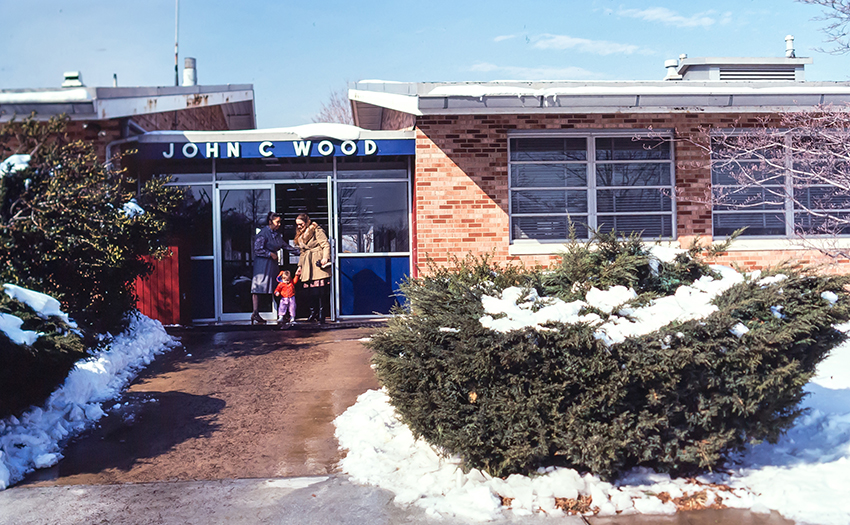School History: John C. Wood Elementary School
Remembering Our Past
In 1961, the Town of Fairfax incorporated as the City of Fairfax. Shortly thereafter, the city established its own School Board. However, all the public schools within the boundaries of the newly formed city were owned and operated by Fairfax County Public Schools. In March 1962, the Fairfax City School Board and the Fairfax County School Board entered into an agreement whereby the city would pay $451.31 per pupil annually for city students to attend the county-owned public schools.
In 1964, in order to relieve overcrowding at Fairfax, Green Acres, Layton Hall, and Westmore elementary schools, the Fairfax City School Board decided to construct a new elementary school. The new school, the first to be built and owned by the city, was designed using a unique “campus” layout. The 16-classroom building would have no interior hallways. Instead, all the classrooms would have doors which opened onto outdoor sidewalks.
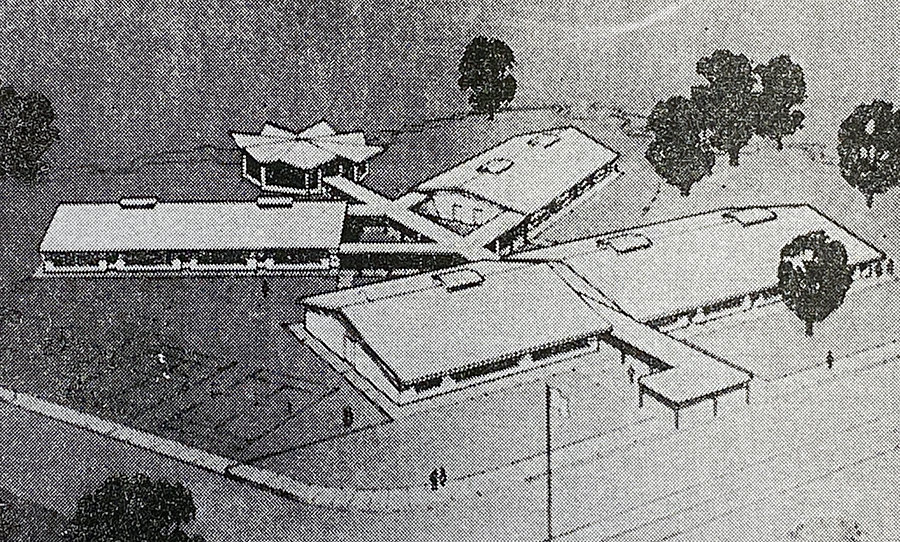
Built by the Wayne Construction Company of Arlington, Virginia, at a cost of $298,596, John C. Wood Elementary School opened on Monday, March 1, 1965, with about 411 students in grades 1-6. The students began the school year at nearby Layton Hall Elementary School. On March 1, in the middle of the school day, the John C. Wood students packed up their desks and walked from Layton Hall to the new building.
What’s in a Name?
John C. Wood Elementary School was named in honor John Clinton Wood, an attorney and public servant. Born in 1918 in New York, John C. Wood moved to Fairfax, Virginia, in 1944 to practice law. Due to a hereditary condition, John Wood’s eyesight began declining while in college, and he became totally blind in 1950. Jack, as he was known, was the attorney for the Fairfax County School Board during the 1950s. He served on the Fairfax Town Council from 1952 to 1961 and was the first mayor of the City of Fairfax. As a member of the Virginia State Council on Higher Education, John Wood was instrumental in the establishment of a branch of the University of Virginia in Fairfax, now called George Mason University. John C. Wood passed away in August 1994 and was buried in Fairfax City Cemetery.
The 1960s
The first principal of John C. Wood Elementary School was Aurelia A. Howland. Alumni recall that Mrs. Howland would play the school’s piano during lunch. She could also remember every child’s name and who their siblings were.
Miss Howland was strict but fair. She didn't mince words with you. You always knew where you stood with her. I respected her and she respected me. ~ Robert L. Jones, Head Custodian, John C. Wood Elementary School, 1965-1983
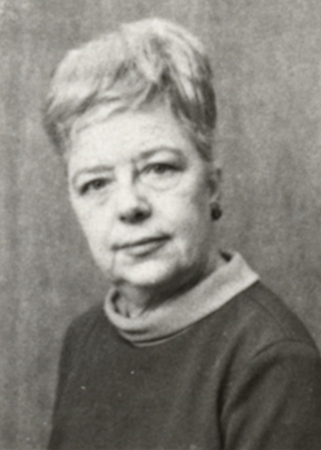
Desegregation
Wood Elementary School opened at a time when Fairfax County was in the process of desegregating its public schools. The last two all-African-American elementary schools, James Lee in Falls Church and Eleven Oaks in Fairfax City, closed in 1966. However, because approximately 95% of the student population at that time was white, many schools remained all-white into the 1970s. Principal Howland recalled in an interview in October 1987 that Wood Elementary School had no African-American children until approximately 1973, when a new apartment complex was constructed within the school’s attendance boundary.
Everything from art objects to pot-bellied stoves will be on sale at the annual May festival of the John C. Wood Elementary School PTA on Saturday at the school. Lunch will be available at the festival, and a mystery National League ball player will be there to talk to the Little Leaguers. There will be pony rides for the youngsters. ~ The Evening Star, April 24, 1966
The First Addition
In 1967, the Fairfax City School Board approved the construction of a 16-room addition to John C. Wood Elementary School. Designed by the architecture firm of Mintz & Easter of Springfield, Virginia, the addition was constructed beginning in the spring of 1968.
The John C. Wood Elementary School will hold its annual book fair in the school library today through Friday. Proceeds from the fair, which will feature books for elementary school children, will go toward purchasing new books and visual education materials for the school library. ~ The Evening Star, November 13, 1967
Welcome Kindergarteners
From 1965 to 1968, Wood Elementary School educated children in grades 1-6. The introduction of kindergarten in elementary schools occurred in 1968. Also in 1968, the administration of John C. Wood and nearby Belle Willard Elementary School was consolidated. Aurelia Howland became principal of both schools and an assistant principal was hired to support Mrs. Howland.
We were a close-knit faculty. The most I think I ever had on the staff, counting all the helping teachers, and all, was about 36. And I always had open house around Christmas or into January somewhere, for all my staff and their families, and their spouses. And think this is good to do. ~ Principal Aurelia Howland
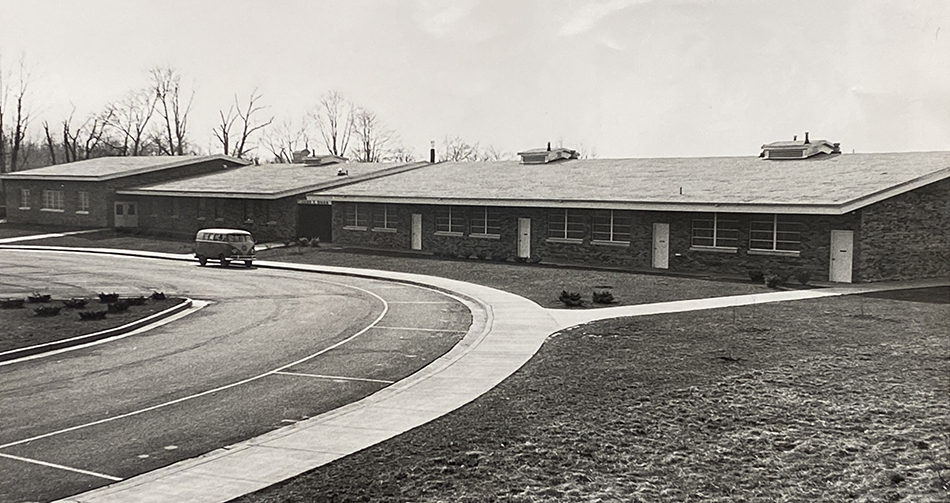
Enrollment Rises and Falls
In the early 1970s, enrollment at John C. Wood Elementary School peaked at approximately 550 students. This necessitated the placement of three classroom trailers behind the building.
One year our emphasis was on the discovery method of learning – largely through science and social studies – and we chose a school project. We made these three huge ceramic hangings of discovery: past, present, and future. They were in the cafeteria. The children did drawings, and then we blew those up, and then the helping teacher in art came and taught us how to crack tile and how to put it all together. That was a rewarding experience. ~ Principal Aurelia Howland
Principal Howland retired in 1976. She was succeeded at Wood Elementary School by Mary H. Hinson, who had formerly served as principal of Fairfax, Freedom Hill, and Jermantown elementary schools.
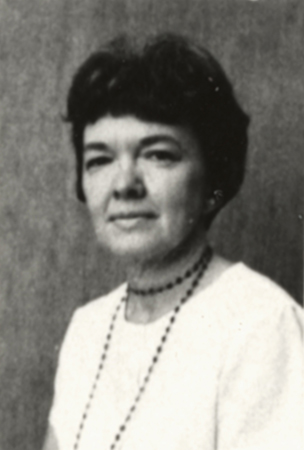
Mary Hinson became principal at a time when enrollment at Wood Elementary School was on the decline. During the late 1970s and into the 1980s, schools that had seen rapid growth during the post-World War II baby boom were suddenly faced with an abundance of empty classrooms.
All classrooms had a door opening directly to the outside. Classrooms had interior sliding doors to the next classroom. These were usually kept shut during school hours. It was delightful to be able to take your class to the playground next door without going through halls. Grades K-3 were in one building and 4-6, plus the library in another. Classes painted murals on the archway walls. In the winter of 1977, I think, it was so cold that overhead water pipes broke in the library and in several classrooms. We were all sent to Fairfax High school for a few weeks. ~ Nancy Smith Scarborough, Teacher, Grades 3-4 Combination Class
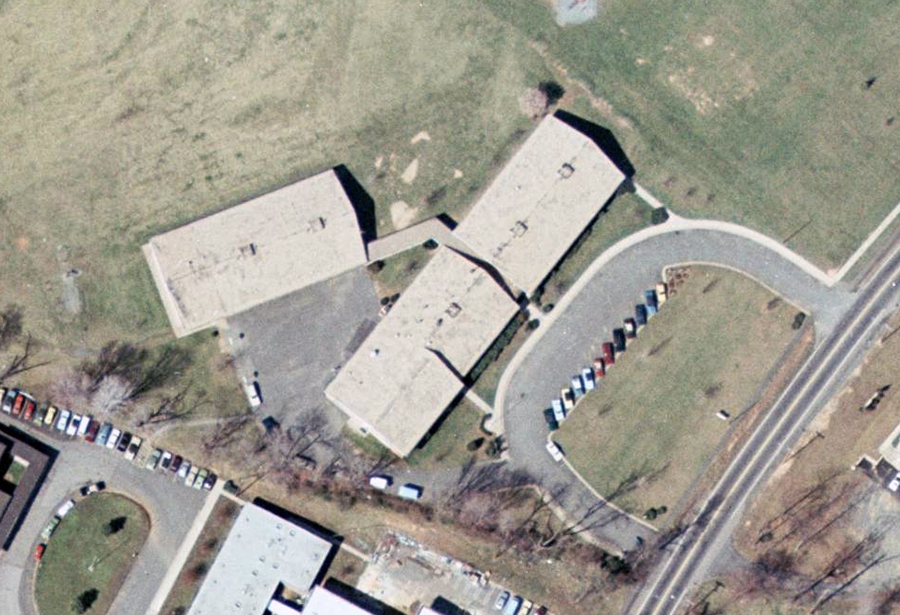
In 1978, parents expressed their concerns about the declining enrollment at Wood Elementary School to School Board members. Parents were deeply troubled about the loss of classroom teachers and what that might mean for students and the remaining staff members.
Teachers with specialties such as physical education, music, or special education are split among the smaller schools. Wood School gets physical education and music teachers two days a week, while a program for handicapped preschool youngsters is operated five days a week. ~ The Fairfax Journal, November 18, 1982
John C. Wood Closes
In 1978, Mary Goins Roots became the third and final principal of John C. Wood Elementary School. During her time as principal, enrollment at the school fell to just 170 students.
The John C. Wood Elementary School has its annual Fun Fair on Saturday at the school. The fair features games, food, a bake sale, and drawings for numerous prizes including a television set. All proceeds benefit the school. ~ The Evening Star, March 19, 1981
In October 1982, the Fairfax City School Board passed a resolution recommending the closure of John C. Wood Elementary School at the end of the 1982-83 school year. Because the school was operated by Fairfax County Public Schools, the decision whether or not to close the school fell to the Fairfax County School Board.
The recommendation to close Wood School will force additions to the facilities at nearby Layton Hall. The Fairfax City School Board recommended that two classrooms be built at Layton Hall, along with a music room and a gymnasium. Layton Hall, a traditional two-story facility built in 1956, houses 250 students in kindergarten through the sixth grade. It, too, has been affected by declining enrollment. It had almost 500 students in 1974. ~ The Fairfax Journal, November 18, 1982
On December 2, 1982, the Fairfax County School Board voted to close John C. Wood Elementary School and consolidate its attendance area with Layton Hall Elementary School. After the school closed in 1983, the building was converted for use by the City of Fairfax Police, Fire, and Parks and Recreation departments. The building was demolished in 2007, and a new police station and community center were constructed on the site.
